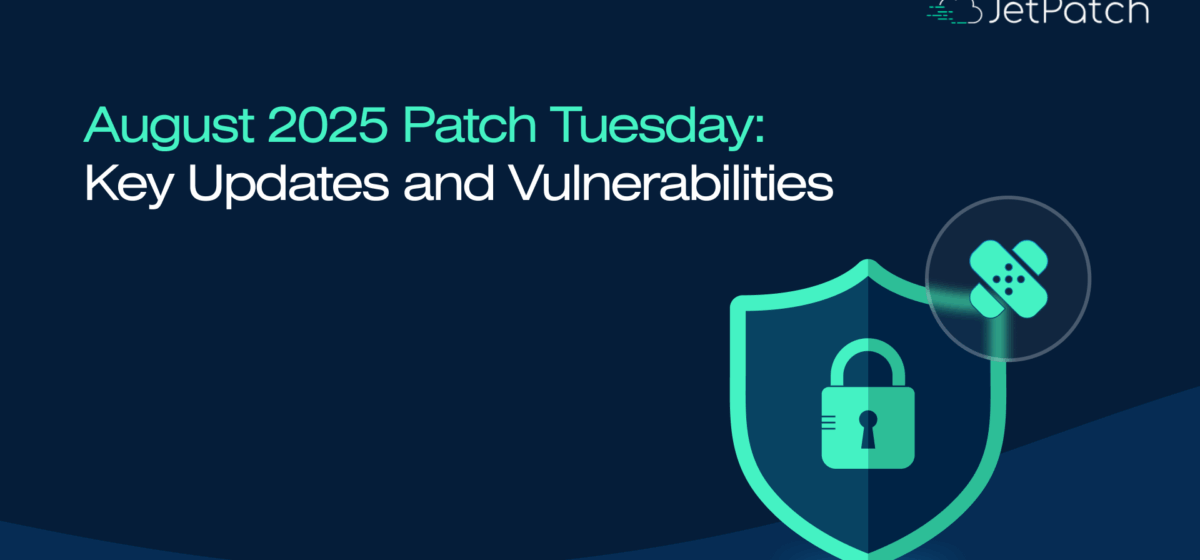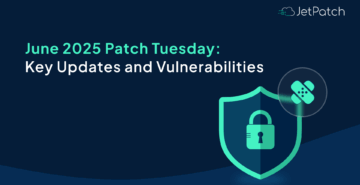The August 2025 Microsoft Patch Tuesday delivers fixes for 111 Microsoft CVEs across Windows, Office, SharePoint, Hyper-V, SQL Server, Azure components, and more. Severity distribution: 5 Critical, 82 High, 24 Medium. Microsoft also republished 8 non-Microsoft CVEs for Chromium-based. Nine items are flagged “Exploitation More Likely,” which raises the risk profile for this month’s patch tuesday cycle.
This follows July 2025, which shipped 130 CVEs with no officially reported zero-days. July was heavier on volume. August is leaner but maintains pressure through high-impact surfaces such as graphics, NTLM, Hyper-V, MSMQ, Office, and Azure services.
As microsoft tuesday rolls in and microsoft patch day windows open, this month’s numbers justify fast validation and targeted rollout. With each ms patch tuesday, IT and security teams must weigh time-to-patch against change risk.
Let’s unpack what August 2025 patch tuesday has in store.
Key CVEs in Microsoft August 2025 Patch Tuesday Updates
Snapshot for this patch tuesday: 111 Microsoft CVEs. Focus clusters around networking (RRAS, WinSock), identity (NTLM), virtualization (Hyper-V), Office apps, and messaging (MSMQ/Exchange). Treat this microsoft patch tuesday as a risk-prioritized rollout month.
Top impacted components (by count)
- Windows Routing and Remote Access Service (RRAS) — 12
- Windows Ancillary Function Driver for WinSock — 7
- Microsoft Exchange Server — 5
- Microsoft Office Excel — 5
- Role: Windows Hyper-V — 5
- SQL Server — 5
- Microsoft Office Word — 4
- Windows Message Queuing (MSMQ) — 4
- Windows Push Notifications — 4
- Microsoft Office (core) — 3
Use this to stage testing rings for microsoft tuesday and microsoft patch day windows, start where counts and blast radius converge.
Critical CVEs (CVSS ≥ 9.0)
| CVE | Component | Base Score | CVSS Vector | Pre-auth / Network / No UI |
| CVE-2025-53767 | Azure OpenAI | 10.0 | CVSS:3.1/AV:N/AC:L/PR:N/UI:N/S:C/C:H/I:H/A:N | Yes |
| CVE-2025-50165 | Microsoft Graphics Component | 9.8 | CVSS:3.1/AV:N/AC:L/PR:N/UI:N/S:U/C:H/I:H/A:H | Yes |
| CVE-2025-53766 | Windows GDI+ | 9.8 | CVSS:3.1/AV:N/AC:L/PR:N/UI:N/S:U/C:H/I:H/A:H | Yes |
| CVE-2025-50171 | Remote Desktop Server | 9.1 | CVSS:3.1/AV:N/AC:L/PR:N/UI:N/S:U/C:H/I:H/A:N | Yes |
| CVE-2025-53792 | Azure Portal | 9.1 | CVSS:3.1/AV:N/AC:L/PR:N/UI:N/S:U/C:H/I:H/A:N | Yes |
Exploitation More Likely CVEs Assessment
| CVE | Component | Base Score | CVSS Vector | Pre-auth / Network / No UI |
| CVE-2025-53778 | Windows NTLM | 8.8 | CVSS:3.1/AV:N/AC:L/PR:L/UI:N/S:U/C:H/I:H/A:H | No |
| CVE-2025-50177 | Windows Message Queuing | 8.1 | CVSS:3.1/AV:N/AC:H/PR:N/UI:N/S:U/C:H/I:H/A:H | Yes |
| CVE-2025-53132 | Windows Win32K – GRFX | 8.0 | CVSS:3.1/AV:N/AC:L/PR:L/UI:R/S:U/C:H/I:H/A:H | No |
| CVE-2025-53786 | Microsoft Exchange Server | 8.0 | CVSS:3.1/AV:N/AC:H/PR:H/UI:N/S:C/C:H/I:H/A:H | No |
| CVE-2025-50168 | Windows Win32K – ICOMP | 7.8 | CVSS:3.1/AV:L/AC:L/PR:L/UI:N/S:U/C:H/I:H/A:H | No |
| CVE-2025-50167 | Role: Windows Hyper-V | 7.0 | CVSS:3.1/AV:L/AC:H/PR:L/UI:N/S:U/C:H/I:H/A:H | No |
| CVE-2025-53147 | WinSock (AFD) | 7.0 | CVSS:3.1/AV:L/AC:H/PR:L/UI:N/S:U/C:H/I:H/A:H | No |
| CVE-2025-49743 | Microsoft Graphics Component | 6.7 | CVSS:3.1/AV:L/AC:H/PR:L/UI:R/S:U/C:H/I:H/A:H | No |
| CVE-2025-53156 | Storage Port Driver | 5.5 | CVSS:3.1/AV:L/AC:L/PR:L/UI:N/S:U/C:H/I:N/A:N | No |
These nine should anchor your ms patch tuesday sequencing.
Pre-auth, network, no user interaction (AV:N + PR:N + UI:N)
Representative high-risk set this month includes: CVE-2025-53767 (Azure OpenAI, 10.0), CVE-2025-50165 (Graphics, 9.8), CVE-2025-53766 (GDI+, 9.8), CVE-2025-50171 (RDS, 9.1), CVE-2025-53792 (Azure Portal, 9.1), and CVE-2025-50177 (MSMQ, 8.1). Treat internet-exposed or file-parsing tiers first during this microsoft patch tuesday cycle.
Implementing August 2025 Patch Tuesday Security Updates
Execute this patch tuesday cycle in three tight stages. Keep the focus on exploitability, exposure, and business impact so your Microsoft patch tuesday rollout moves fast without breaking critical services.
Step 1: Risk triage and scope definition
Start with a precise inventory of where August components run. Use discovery scans, CMDB ownership, and attack-surface maps to locate the affected tiers. Tag systems that are internet facing, sit on likely lateral-movement routes, or host business-critical services. Prioritize three groups from the August Microsoft patch day data:
A) Critical CVEs (CVSS ≥ 9.0) — 5 items
- CVE-2025-53767 (Azure OpenAI, 10.0)
- CVE-2025-50165 (Microsoft Graphics Component, 9.8)
- CVE-2025-53766 (Windows GDI+, 9.8)
- CVE-2025-50171 (Remote Desktop Server, 9.1)
- CVE-2025-53792 (Azure Portal, 9.1)
B) “Exploitation More Likely” — 9 items
- CVE-2025-53778 (Windows NTLM)
- CVE-2025-50177 (Windows Message Queuing)
- CVE-2025-53132 (Windows Win32K – GRFX)
- CVE-2025-53786 (Microsoft Exchange Server)
- CVE-2025-50168 (Windows Win32K – ICOMP)
- CVE-2025-50167 (Role: Windows Hyper-V)
- CVE-2025-53147 (AFD/WinSock)
- CVE-2025-49743 (Microsoft Graphics Component)
- CVE-2025-53156 (Storage Port Driver)
Replace the “Pre-auth, network, no user interaction” block with:
Items with AV:N, PR:N, and UI:N in the CVSS vector (no authentication or user action required) — 14 total:
CVE-2025-53767 (Azure OpenAI), CVE-2025-50165 (Microsoft Graphics Component), CVE-2025-53766 (Windows GDI+), CVE-2025-50171 (Remote Desktop Server), CVE-2025-53792 (Azure Portal), CVE-2025-50177 (Windows Message Queuing), CVE-2025-53722 (Windows Remote Desktop Services), CVE-2025-50154 (Windows File Explorer), CVE-2025-53793 (Azure Stack), CVE-2025-53774 (Microsoft 365 Copilot’s Business Chat), CVE-2025-53787 (Microsoft 365 Copilot’s Business Chat), CVE-2025-33051 (Microsoft Exchange Server), CVE-2025-25006 (Microsoft Exchange Server), CVE-2025-25007 (Microsoft Exchange Server).
Why this step matters: It concentrates effort on what reduces risk the fastest. You enter ms patch tuesday with a clear list and owners per asset class.
Step 2: Orchestrated rollout by rings
With scope locked, push updates in ordered rings that mirror production diversity.
Ring A: Internet-facing and file-parsing tiers that cover the five Critical CVEs and MSMQ (CVE-2025-50177). Include RDS hosts and Azure admin planes.
Ring B: Identity and access infrastructure. Patch NTLM and the Win32K items in this wave.
Ring C: Messaging and virtualization estates: Exchange DAG members and Hyper-V parent partitions.
Ring D: Everything else. Finish with remaining server roles and the broader Windows endpoint fleet.
Efficiency gains: Ringing cuts blast radius, speeds validation, and improves time-to-coverage during your Microsoft tuesday change windows.
Recommended practices:
Use a small but realistic pre-prod slice per ring. Validate graphics rendering, document handling, and print paths first due to GDI+ / Graphics risk.
For MSMQ, confirm the feature is required. Remove or restrict where possible before rollout.
Harden while patching: constrain RDP to management networks, apply conditional access on Azure Portal, and limit document previewing until coverage is confirmed.
Stagger Microsoft patch tuesday maintenance windows by region or BU to protect SLAs.
Step 3: Verification, telemetry, and compliance closeout
After deployment, prove the outcome.
Monitor: Patch success, reboot compliance, service health, and CVE coverage for the nine “More Likely” items and the five.
Validate: Confirm remediation on systems that carried AV:N + PR:N + UI:N vectors. Spot-check business workflows that rely on graphics, RDS, Exchange, and Hyper-V.
Report: Produce per-ring evidence with exceptions, retries, and owner acknowledgments. Store artifacts for audit.
Importance: This confirms the Microsoft patch day actually reduced exposure and that posture remains stable before the next Microsoft patch tuesday. It also prevents drift and shortens recovery if a rollback is needed during the next ms patch tuesday cycle.
Conclusion
The August 2025 patch tuesday addressed 111 vulnerabilities, including severe issues such as CVE-2025-53767 (Azure OpenAI, CVSS 10.0) and CVE-2025-50165 (Microsoft Graphics Component, CVSS 9.8). Impacted surfaces span Azure Portal, Remote Desktop Server, Exchange, Hyper-V, RRAS and WinSock networking, and Microsoft Office.
The breadth of this microsoft patch tuesday underscores the value of disciplined, automated remediation across diverse estates.
JetPatch reduces the complexity of ms patch tuesday operations by automating detection, risk-based prioritization, staged testing, deployment, and rollback. Policy rules push the most exploitable items first. Automated validation contains change risk.
Unified visibility and compliance reporting keep security, IT, and audit on the same page so updates land during your Microsoft patch day windows without disrupting critical services. If you want a compact feature and integration summary, explore Patch Management Datasheet.
For more information, contact us to schedule a personalized demo.


